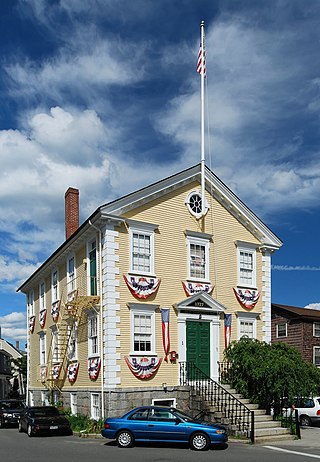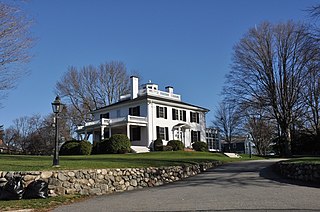
Salem is a historic coastal city in Essex County, Massachusetts, United States, located on the North Shore of Greater Boston. Continuous settlement by Europeans began in 1626 with English colonists. Salem was one of the most significant seaports trading commodities in early American history. Prior to the dissolution of county governments in Massachusetts in 1999, it served as one of two county seats for Essex County, alongside Lawrence.

Samuel McIntire was an American architect and craftsman, best known for his work in the Chestnut Street District, a classic example of Federal style architecture.

The Salem Maritime National Historic Site is a National Historic Site consisting of 12 historic structures, one replica tall-ship, and about 9 acres of land along the waterfront of Salem Harbor in Salem, Massachusetts, United States. Salem Maritime is the first National Historic Site established in the United States. It interprets the Triangle Trade during the colonial period, in cotton, rum, sugar and slaves; the actions of privateers during the American Revolution; and global maritime trade with the Far East, after independence. The National Park Service manages both the National Historic Site and a Regional Visitor Center in downtown Salem. The National Park Service (NPS) is an agency of the United States Department of the Interior.

Downtown is the central business district of Washington, D.C., located in Northwest D.C. It is the third largest central business district in the United States. The "Traditional Downtown" has been defined as an area roughly between Union Station in the east and 16th Street NW in the west, and between the National Mall on the south and Massachusetts Avenue on the north, including Penn Quarter. However, nowadays, Downtown D.C. can often refer to a larger area, as the DC Office of Planning states:
…most residents, workers, and visitors think of Downtown in a broader sense — including areas as far north as Dupont Circle, as far west as Foggy Bottom, and as far east as Capitol Hill. Only about half of the central city workforce is located within the city’s traditional Downtown.

Hamilton Hall is a National Historic Landmark at 9 Chestnut Street in Salem, Massachusetts. Designed by noted Salem builder Samuel McIntire and built in 1805–1807, it is an excellent instance of a public Federal style building. It was built as a social space for the leading families of Salem, and was named for Founding Father and Federalist Party leader Alexander Hamilton. It continues to function as a social hall today: it is used for events, private functions, weddings and is also home to a series of lectures that originated in 1944 by the Ladies Committee.

The First Religious Society Church and Parish Hall is a historic church building at 26 Pleasant Street in Newburyport, Massachusetts. Originally a Reformed congregation, the congregation is currently affiliated with the Unitarian Universalist denomination. The current Minister is Reverend Rebecca M. Bryan. The church's steeple is currently the tallest point in downtown Newburyport, Massachusetts.

The Chestnut Street District is a historic district bounded roughly by Bridge, Lynn, Beckford, and River Streets in Salem, Massachusetts. It was added to the National Register of Historic Places in 1973 and enlarged slightly in 1978. The district contains a number of architecturally significant works of Samuel McIntire, a builder and woodworker who had a house and workshop at 31 Summer Street, and who designed and built a number of these houses, and others that display the profits made in the Old China Trade by Salem's merchants. The district is a subset of a larger locally designated McIntire Historic District.

City Hall is a historic government building located in the Downtown Salem District of Salem, Massachusetts.

The Historic Derby Street Neighborhood, also known as the Derby Waterfront District in Salem, Massachusetts encompasses a historically significant portion of the waterfront area of the city. It encompasses properties along Derby Street, which parallels the waterfront, eastward from the Salem Maritime National Historic Site to its junction with Fort Avenue, and includes properties on the side streets between Derby and the waterfront. In addition to the National Historic Site, it includes the House of Seven Gables, a National Historic Landmark District.

The Essex Institute Historic District is a historic district at 134-132, 128, 126 Essex Street and 13 Washington Square West in Salem, Massachusetts. It consists of a compact group of properties associated with the Essex Institute, founded in 1848 and merged in 1992 into the Peabody Essex Museum. Listed by increasing street number, they are: the Crowninshield-Bentley House, the Gardner-Pingree House, the John Tucker Daland House, and the Phillips Library. The John Ward House, which fronts on Brown Street but shares the 132 Essex Street address, is another National Historic Landmark within the district. The Andrew Safford House at 13 Washington Square West, built in 1819, was said to be the most expensive home in New England at the time.

The Old Town House is in the heart of the Marblehead Historic District at One Market Square in Marblehead, Massachusetts, at the intersection of Washington, State, and Mugford Streets.

The Washington Street Historic District encompasses a fashionable 19th-century residential area near downtown Peabody, Massachusetts. It extends along Washington, Holten, and Sewall Streets, and is where business and civic leaders of the community built their homes. The district was added to the National Register of Historic Places in 1985.

The Joshua Ward House is a historic house in Salem, Massachusetts. The three-story Federal style brick house, built in 1784, is one of the first brick houses in Salem. Its interior woodwork was done by noted Salem builder and woodworker Samuel McIntire, including an original staircase that is the oldest surviving staircase created by him. George Washington is reported to have specifically requested staying in this house when he visited Salem in 1789.

Salem Common Historic District is a historic district bounded roughly by Bridge, Derby, and St. Peter's streets, as well as Collins Cove in Salem, Massachusetts, United States.

Beebe Homestead, also known as the Lucius Beebe House and Beebe Farm, is a historic Federal period home at 142 Main Street in Wakefield, Massachusetts, which was built during the federal era that extended from the late 18th-century into the 1820s. It is suspected to have been remodeled into the federal style from an earlier home built in circa 1727. It overlooks Lake Quannapowitt, and according to a 1989 study of historic sites in Wakefield, the house is "one of Wakefield's most imposing landmarks." The property was added to the National Register of Historic Places in 1989.

The Central Square Historic District is a historic district encompassing the central town common of the city of Waltham, Massachusetts, and several commercial buildings facing the common or in its immediate vicinity. The common is bounded by Carter, Moody, Main, and Elm Streets; the district includes fourteen buildings, which are located on Main, Elm, Lexington, and Church Streets, on the north and east side of the common. The district was listed on the National Register of Historic Places in 1989.

The Worcester City Hall and Common, the civic heart of the city, are a historic city hall and town common at 455 Main Street in Worcester, Massachusetts. The city hall and common were added to the National Register of Historic Places in 1978.

The Church Street Marketplace is an uncovered outdoor pedestrian shopping and dining mall in Burlington, Vermont, consisting of the four blocks of Church Street between Main and Pearl Streets. The mall was initially conceived in 1958 and was built in 1980-81 to a design by Carr, Lynch Associates of Cambridge, Massachusetts. It encompasses about 86 storefronts and is managed by the Church Street Marketplace Commission.
This is a timeline of the history of the city of Salem, Massachusetts, United States.

Holman K. Wheeler was a prolific Massachusetts architect. Wheeler is responsible for designing more than 400 structures in the city of Lynn alone, including the iconic High Rock Tower which is featured prominently on the Lynn city seal. While practicing in Lynn and Boston over a career spanning at least 35 years Wheeler designed structures throughout the Essex County area, including Haverhill, Marblehead, Newburyport, Salem, Swampscott, and Lynn. Wheeler is responsible for a total of five Lynn structures listed on the National Register of Historic Places, more than any other person or firm.
























